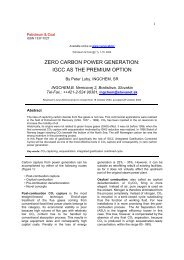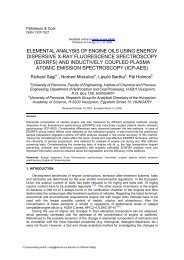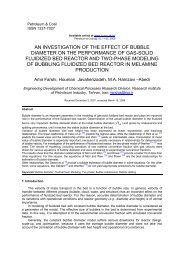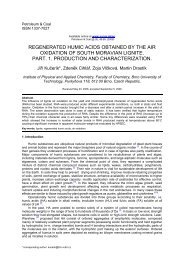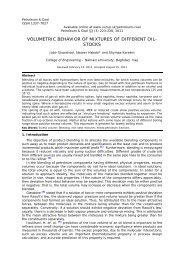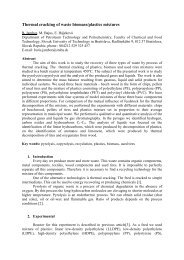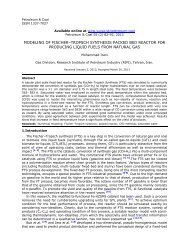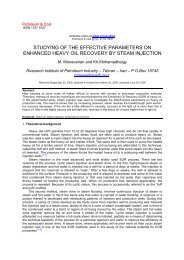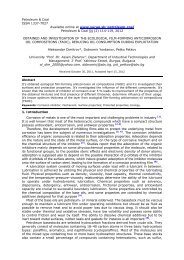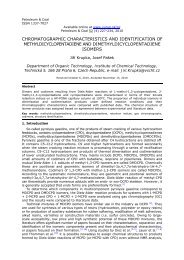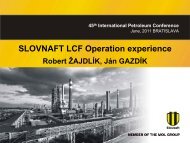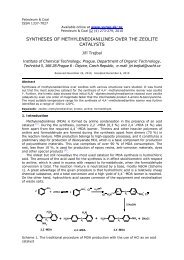Estimation of measurement uncertainty for the determination of the ...
Estimation of measurement uncertainty for the determination of the ...
Estimation of measurement uncertainty for the determination of the ...
Create successful ePaper yourself
Turn your PDF publications into a flip-book with our unique Google optimized e-Paper software.
oils [11] . UFO is not suitable <strong>for</strong> human consumption but is a feedstock <strong>for</strong> biodieselproduction. Its usage significantly reduces <strong>the</strong> cost <strong>of</strong> biodiesel production. However, <strong>the</strong>quality <strong>of</strong> UFO may cause concern because its physical and chemical properties depend on <strong>the</strong>contents <strong>of</strong> fresh cooking oil and UFO may contain lots <strong>of</strong> undesired impurity, such aswater, free fatty acids [2,11- 13] . Since <strong>the</strong> cost <strong>of</strong> raw materials accounts about 60–80%<strong>of</strong> <strong>the</strong> total cost <strong>of</strong> biodiesel production, choosing a right feedstock is very important[2,11] . Also, <strong>the</strong> yield and properties <strong>of</strong> biodiesel products produced from differentfeedstocks would be quite different from each o<strong>the</strong>r.C<strong>of</strong>fee, toge<strong>the</strong>r with tea, is one <strong>of</strong> <strong>the</strong> most popular drinks across <strong>the</strong> world. Its commercialand social importance is obvious. C<strong>of</strong>fee production is located mainly in South America,Brazil being <strong>the</strong> first producing country (42%). Africa accounts <strong>for</strong> 20.4% <strong>of</strong> <strong>the</strong> total productionand Asia produces 18.5%. Never<strong>the</strong>less, Europe is <strong>the</strong> main c<strong>of</strong>fee consumer [14] . Thereare two varieties <strong>of</strong> <strong>the</strong> c<strong>of</strong>fee plant with economic importance: C<strong>of</strong>fea arabica and C<strong>of</strong>feacanephora, known in <strong>the</strong> trade as arabica and robusta, respectively. C<strong>of</strong>fee beveragesare made from roasted beans belonging to one <strong>of</strong> <strong>the</strong>se two varieties or blends <strong>of</strong> <strong>the</strong>m.The better quality c<strong>of</strong>fees, and thus <strong>the</strong> most expensive ones, are considered to be <strong>the</strong>arabicas [15] . Frequently, green c<strong>of</strong>fee beans <strong>of</strong> <strong>the</strong> arabica and robusta varieties can bedistinguished by <strong>the</strong>ir size but <strong>the</strong> roasting process eliminates this macroscopic criterion.There<strong>for</strong>e, reliable methods are required to differentiate <strong>the</strong>se varieties [16].Clearly, <strong>the</strong> procedures used in fat extractions are not standardized. In this study, weattempted to quantify <strong>the</strong> variation resulting from using different methods <strong>of</strong> waste c<strong>of</strong>feeresidue preparation and <strong>the</strong>n lipid extraction by n-hexane, when it is used in Soxhlet extractor.2. Experimental2.1. MaterialsThe c<strong>of</strong>fee residue “Bianchi” from vending-machine was used <strong>for</strong> <strong>the</strong> experiments. Anorganic solvent n-hexane with analytical grade was obtained from Sigma-Aldrich Ltd.(Germany).3. MethodsD. I. Yordanov, Z. B. Tsonev, T. V. Palichev, Z. A. Mustafa/Petroleum & Coal 55(2) 74-81, 2013 753.1. Microwave assisted <strong>the</strong>rmal treatment <strong>of</strong> <strong>the</strong> c<strong>of</strong>fee residueThe experiment was conducted inside a fume hood in <strong>the</strong> laboratory using a SamsungMW 82N. The procedure used as <strong>the</strong> initial guideline <strong>for</strong> our experiment was as follows:A) We were prepared 20g sample <strong>of</strong> c<strong>of</strong>fee residue in 800cm 3 flask, cover with upsidedown750cm 3 flask.B) Then we were placed in microwave cavity, microwave <strong>for</strong> 20 minutes at (300W, 450Wand 600W).C) Finally we were removed <strong>the</strong> product from microwave using tongs, allowed cooling,and weighting <strong>the</strong> solid pyrolyzate.3.2. N-hexane oil extraction via Soxhlet apparatusOil extraction was per<strong>for</strong>med using a Chemglass 300cm 3 Soxhlet apparatus with n-hexaneas solvent. The Soxhlet apparatus allowed <strong>the</strong> extraction <strong>of</strong> oil from <strong>the</strong> c<strong>of</strong>fee residueusing a distillation extraction method. Twenty grams <strong>of</strong> c<strong>of</strong>fee residue were placed into aporous cellulose thimble inside <strong>the</strong> extraction chamber. The extraction chamber was placedinto <strong>the</strong> Soxhlet apparatus above a flask containing 300cm 3 <strong>of</strong> n-hexane and under anoverhead condenser. The flask was submerged in a water bath and heated to approximately90°C using a hotplate, evaporating <strong>the</strong> solvent into <strong>the</strong> condenser which trickled back downinto <strong>the</strong> extraction chamber soaking <strong>the</strong> c<strong>of</strong>fee residue. Eventually <strong>the</strong> oil was concentratedin <strong>the</strong> bottom flask, and <strong>the</strong> n-hexane was evaporated and reclaimed into ano<strong>the</strong>r flaskusing an overhead condenser leaving only <strong>the</strong> lipids behind.3.3. Analytical methods3.3.1. Gas chromatography with mass spectrometryTo determine <strong>the</strong> fatty acid composition <strong>of</strong> <strong>the</strong> total lipid extracts, aliquots were subjectedto acid-catalysed transesterification [17] and <strong>the</strong> resulting fatty acid methyl esters purifiedby thin layer chromatography on silica-coated glass plates using hexane:acetone (100:8v/v) as developing solvent. After that, <strong>the</strong> purified fatty acid methyl esters were analysedby capillary gas chromatography as follows: Apparatus TRACE GC ULTRA (Thermo Fisher



